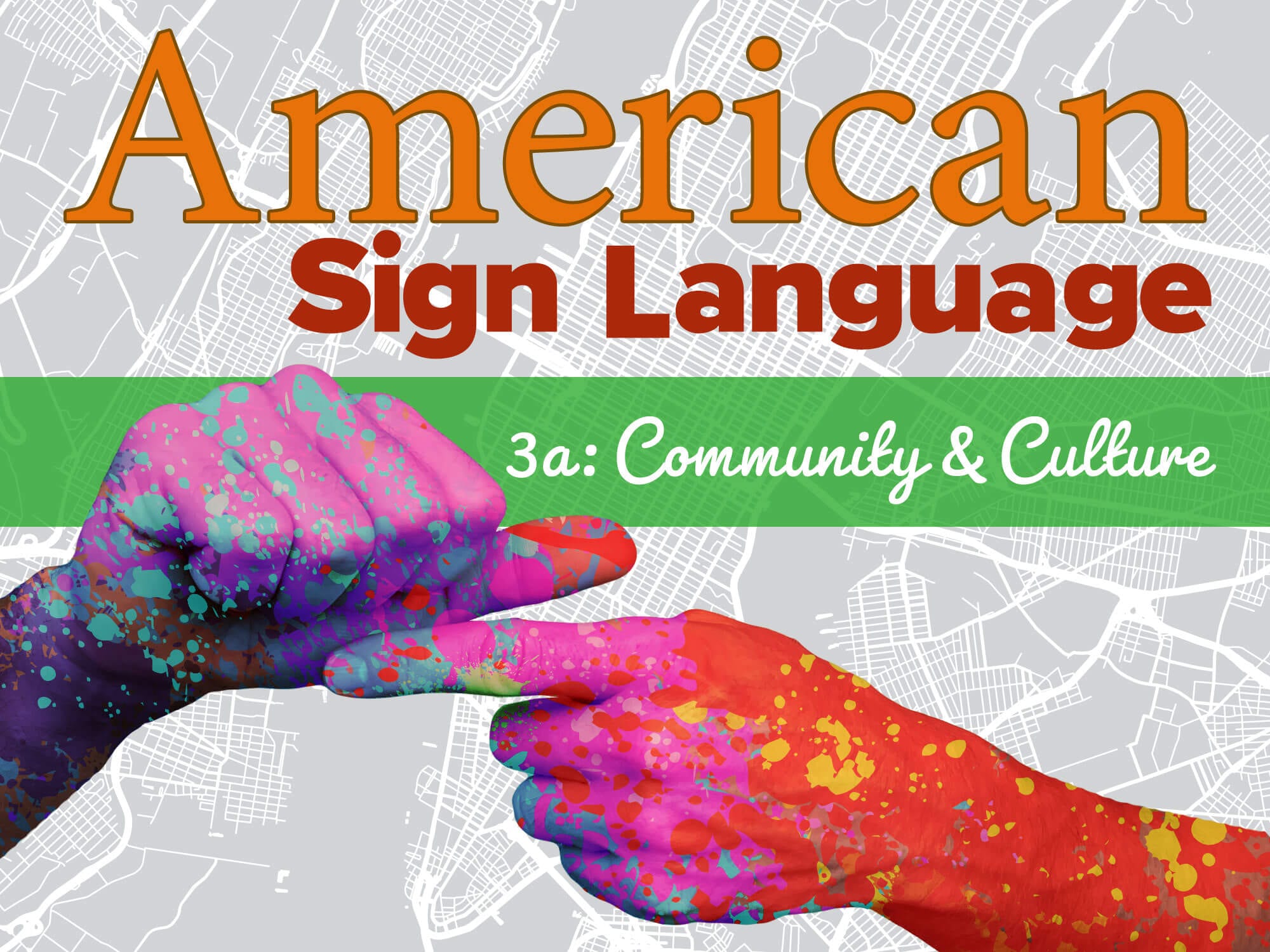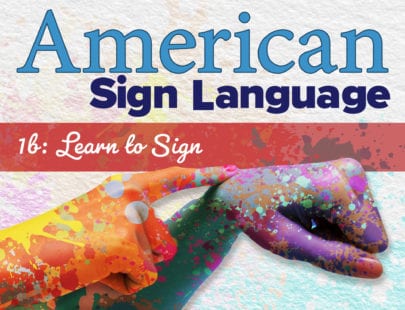
American Sign Language 3a: Community & Culture
As you dive into more advanced ASL signing, including unique grammar features and advanced classifiers and locatives, you’ll learn, compose, and present your new-found vocabulary and narratives by immersing yourself in Deaf culture and community. From opinions, slang, and idioms, to using technology and media that offers authentic Deaf perspectives. Explore how travel, cultural differences, and geography affect sign language. And gain a better understanding of Deaf culture by learning important events and examining topics such as education, science, and literature.
Units at a Glance
Unit 1: Getting Back Into Signing: Conversations and Opinions
Time to get back into signing by having fun conversations in American Sign Language. Being an effective communicator in ASL requires not just technical proficiency with the language but also sensitivity to the culture and ways of communicating. We’ll review conversational norms and some of the stereotypes that Deaf people face, and we’ll get a chance to converse about these topics. Discussing deafness can be a very personal subject for people, so we will learn some new signs to help us discuss Deaf topics and converse about sensitive issues in a compassionate way.
What will you learn in this unit?
- Apply ideas about culture to produce more effective communication in ASL
- Differentiate familiar grammar elements in natural ASL conversations
- Analyze Deaf stereotypes to better understand Deaf experiences
- Connect knowledge of Deaf history and culture with signing to converse about these topics
Unit 2: Rites of Passage in Deaf and Hearing Cultures
Whether or not math is your favorite subject, money, data, and science are increasingly important parts of our everyday lives—learning how to sign these concepts can be fun and, most importantly, useful. From numbers, we move on to the intricacies of dates and addresses and then look at how some important dates in Deaf history have created modern-day celebrations. The most influential dates in Deaf history almost all involve education and sign language, and we will look at how the education system gave rise to our modern idea of Deaf culture. And education plays a prominent role in how people come to form a social identity, especially a Deaf cultural identity. Come trace the history and scholarship that give us tools to talk about identity in Deaf culture.
What will you learn in this unit?
- Integrate ASL with mathematical knowledge to communicate about increasingly advanced numerical ideas
- Correctly sequence and formulate ideas about time in ASL
- Relate Deaf history to Deaf events
- Distinguish and postulate ideas about the relationship of Deaf education with Deaf identity formation
Unit 3: Directions and Travel
American Sign Language has unique grammar features that you must know to use the language properly and fully. Come along for a trip while we learn how to sign the names of all 50 states and most countries around the world and get deeper into giving directions. With a language that has so many advantages in describing space, it would be a shame not to fully take advantage of the ability to give directions and go to faraway places. We will also discuss cultural differences, geography, and how these affect language, especially sign language.
What will you learn in this unit?
- Formulate methods of remembering signs for place names based on fingerspelling or more nuanced sign names
- Construct ASL presentations correctly using advanced classifiers and locatives
- Analyze the history of any world sign language to uncover cultural and geographic influences
- Plan a complex trip using proper grammar, place names, explanations of directions, descriptions of the landscape and fauna, clothing styles in the destination, and cultural details
Unit 4: Opinions in a Digital World
“Don’t be so judgemental!” While parents might want you to stop being judgy, it is human nature to have and express opinions, so we will now expand our opinionated vocabulary. Since Non-Manual Markers are important grammatical features of ASL, let’s review and clarify some of them so you will have the full range of expression available to you in ASL. Since the media is full of opinions, we’ll dive into how deafness is portrayed in the media, and how changes in captioning laws are pushing broadcasters to improve captioning and accessibility for the deaf. We can’t talk about the media without bringing in social media, so let’s learn the signs for the technologies we use every day, and a bit of slang and a few idioms as well. Being deaf doesn’t mean you can’t participate in the media, expressing opinions or working behind the scenes. We’ll look at ways that everyone can get a better understanding of Deaf culture by exploring media, both amateur and professional, that offers authentic Deaf perspectives.
What will you learn in this unit?
- Connect new and previously learned NMMs to their uses in ASL discussions
- Investigate the compliance of captioning laws
- Formulate ASL sentences about new technologies, using internet slang in ASL
- Compare various opinions from the Deaf community to better understand the range of perspectives
Unit 5: Favorite Subjects: Explore Your Passion
Nothing engages us like something we are passionate about—and we’re all different. Everything from the mysteries of mathematics to the joy of riding horses or the smell of a homemade pie baking in the oven. We will learn ASL signs for some more subjects and activities and then discuss how we can use more formal ASL to employ these new signs to make academic presentations. Plus we will sort out some concepts around lexicalization, do some fingerspelling drills for receptive and active practice, and then look at how ASL both contributes to science and is enhanced by the invigorating efforts to create new signs for complex new STEM concepts. Let the signing begin.
What will you learn in this unit?
- Differentiate between signs for distinct academic disciplines
- Distinguish between Signed English and Academic ASL, analyzing the different registers of ASL in more or less formal settings
- Compare lexicalized signs to their fingerspelled words, understanding the evolution that occurs when signs are lexicalized
- Investigate the history of ASL linguistics to trace the influence that ASL has had on science and humanities since Stokoe’s initial research
Unit 6: Unforgettable Stories in ASL
Getting up to present is fun—and nerve-wracking! But put your nervous energy to good use by telling great stories in ASL. Follow along as we learn some rules, tools, and tips for “showing” (not telling!) great ASL stories. We’ll trace the history of ASL literature through to the present and discuss literacy in languages that do not have a written form. Once you understand how and why ASL literature is important to the Deaf community, you will be raring to go and try your hand at some ASL storytelling—all the while advancing your knowledge and skill in ASL!
What will you learn in this unit?
- Apply narrative tools to storytelling in ASL
- Trace the history of ASL literature
- Relate the concepts of literacy and cultural appropriation to Deaf culture
- Compose and perform an original story in ASL
Required Materials
Students in ASL 3a and 3b will need to practice their conversational ASL skills with a partner or group to advance their language skills to the intermediate level. For safety reasons, we ask that the teacher or school district locate another ASL student or member of the Deaf community who is willing to be a conversation partner in person or over video chat. If this conversation partner is not able to meet, the student will need the school district or teacher to locate an alternate conversation partner with whom to practice and complete assignments.
Physical
- Video recording device
- Pencil or pen
- Scanner or camera to digitize map
- Materials to create a promotional tool (can be created and then a picture of the tool can be uploaded—poster, markers, glue, etc.)
Software
- Word processing software
- Materials to create a promotional tool (can be digital—video, slideshow, etc.)
Other
- Friend(s), family member(s), or conversation partner(s) for demonstration purposes
- Community member from another country for conversation



